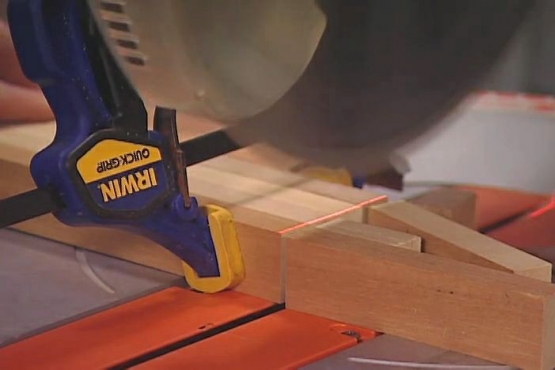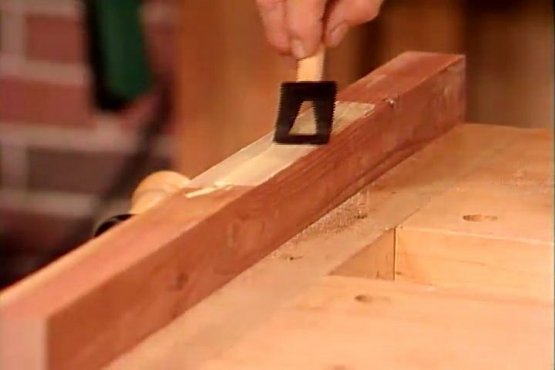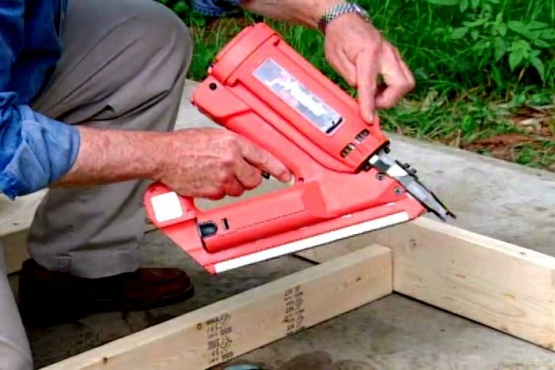My last house call brings me back to Salt Lake where Robert Kramden and his daughter have asked me to diagnose their living room wall and see if I can prescribe a plate rail that will help them showcase their art work and collectibles.
RH: Hey, Robert!
RK: Hi Ron! How you doing?
RH: Very good. Thank you. You must be Carin?
CK: Yes.
RH: Father/daughter team?
CK: Yes. Can we go inside and take a look?
RK: Sure. Come on let’s go. Well, Ron, what we’d like to do is recreate an arts and crafts style plate rail around three walls of our living room.
RH: Yeah, that should look good up there.
RK: I actually have a picture of something that we’d like . . . that we’d kind of like to try and do.
RH: Oh yeah, this one right here?
RK: Yeah.
RH: I like that. I think it’ll look very nice in here. Well, here’s what I’d like to do. Let’s pull all the furniture away from the walls and then I want to make some measurements, okay?
RK: Okay. Great.
RH: Carin and I hold a strip of wood on the wall at various heights while Robert decides which he likes best. Five feet seems to be just about right. Next we carefully measure the width of the walls.
RK: I got 12’ 10”.
RH: Now it’s time to head out to our temporary work shop in the garage. We’ve kind of taken over your garage here.
RK: Boy, I’d say.
RH: I unloaded some things from the mobile workshop. These are the tools that we’re going to be using today: table saw, power mitre box and thickness planer. This is the wood I’ve chosen for the project, oak because a lot of your furniture in there is oak.
RK: Right.
RH: I’ve also chosen pieces that are nice and dry. They’re flat, they’re not cupped in this direction and also they are really straight and that’s going to save us a lot of work, starting with this great lumber like this.
RK: Okay.
RH: So, if you guys are ready why dont’ we begin by cutting out some of the parts for this.
RK: Okay.
RH: We used the table saw to cut our rip our wood to the proper width. Like most lumber oak comes in standard thicknesses. For our project though we’ll need some thinner pieces and that’s a job for the thickness planer. With our wood at the proper width and thickness we can now use the power mitre box to cut it to lenght. Some of the ends require angles or mitre cuts. Well, it’s time to start assembling. Our design consists of a shelf, a ledger or back support and some trim pieces. We’ll start with the shelf itself.
RK: Ron, this is an example of what we’d like to put on the shelf.
RH: It’s copper.
RK: Yes, it is. Hammered copper.
RH: All right. To keep these from slipping like this. What I’d like to do first is to cut a grove in the top of the shelf to receive the edge or the lip of the plate and keep it upright. The tool that I want to use to do that is a router. I’ve got a straight cutting bit in here. It’s a rotary cutting tool that’ll spin and this fence or guide right here is going to run right along the edge of the board. Eye protection is a must with this tool. The cutter spins very rapidly and can propel wood chips and splinters at very high speeds. As the router is pushed along the board it leaves behind a clean precise groove, just the right width to hold the edge of those decorative plates. Now, Carin, the longest wall in that living room is longer than the longest board I’ve got so we’re going to have to join to boards together to make the shelf as long as we need it. It’d be good to do that using something called biscuit joiner. This is called a plate joiner. This has got a cutter bit under here. It’s going to cut a slot in the end of the boards. What I want you to do is place this right on top of the board. Go ahead and take hold of it.
CK: Okay.
RH: Push it all the way in and then take it out. Pull away. Look right here. See, you just cut yourself a gap.
CK: Oh, yeah.
RH: Okay, Carin, put some glue right in those spots you just cut there.
CK: Okay.
RH: There you go. Oval shaped biscuits as they are called made of compressed wood are then inserted into the slots. These tabs are then put into slots in the adjoining board. Once the glue dries Robert uses as random orbital sander to smooth the joint. Our design calls for a strip of wood to be attached to the edge of the shelf. Now, this is the lip that’s going to go on the front of the shelf. So, Robert if you would give me a bead of glue right down through here. Carin, over on this side please.
CK: Okay.
RH: Your already to go into cake decorating. With the glue in place the lip is pressed onto the front edge and held in place with finish nails. Now it’s time to attach the ledger to the rear edge. This strip of wood will allow us to mount the shelf to the wall. Here again, glue is applied to the edge of the board. Then the ledger is set in position and held in place with clamps. We want maximum strength from this joint so we’ll first bore pilot holes then insert screws. Okay, the ledger is on. Let’s lay this flat on the bench again and I’ll clamp this so it won’t move around. Now, what I want to do is plug up these screw holes here with some decorative button plugs. Okay, nice button job. Let’s turn it back over one last time here. We’re going to put some trim now on the bottom of the ledger. This piece of trim is largely decorative. Glue and nails will hold it in place. All right guys, turn it up like this. Now. Dental blocks are the next detail to be added to the art shelf. The dental blocks will be placed right in here. They are made by first gluing, then nailing together two small squares of oak. The blocks are then attached to the ledger from the back. The shelf is assembled. Now, it’s time for a final sanding. Then a coat of golden oak stain varnish to add color and luster. Now, we’re ready for installation. First we draw a level line on the wall then install a strip of wood that will act as a temporary support. The shelf is attached by drilling clearance holes into the ledger and then installing screws directly into the wall studs. We connect the sections with biscuit joints to align the edges and reinforce the corners. Our final piece of decorative trim is a prefinished strip of oak that covers the screw heads. Now this is truly an art gallery. I like it!
CK: Me too.
RH: You guys did a great job.
RK: Thanks.
RH: It just adds such a nice touch to this room. Ties in the whole arts and crafts feel.
RK: Yes.
RH: You were wonderful to work with. My first father and daughter team.
RK: Well, thank you very much.
CK: Thank you.
RH: Enjoy guys.
RK: Thanks. It really, really makes the living room look great doesn’t it?
CK: Yeah.
RK: Well, honey, thanks for all your help doing this.
CK: Your welcome. I had fun.
RK: Thank you.










